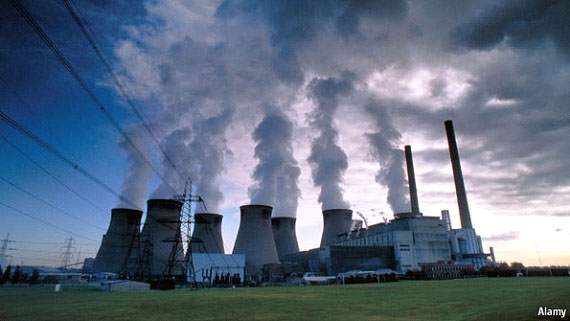『碳收集及储存技术是实施全球低碳计划的一项很好的技术,它的发展势头很好,目前有很多相关项目正在进行,但是它也遇到了很多阻碍。』
Deep storage
低碳计划之碳收集及储存技术

IN the push to tackle climate change, most attention is devoted to ditching fossil fuels for low-carbon power sources. But the fight has another prong: stripping carbon dioxide out of the smokestacks of power plants and other factories and storing it safely underground. The distinct parts of this process, known as carbon capture and storage (CCS), are already in operation. But no one has yet joined them together on an industrial scale. So it was a blow when the government recently scrapped plans to build the country’s first CCS unit at the Longannet coal-fired power station in Scotland, claiming it cost too much.
The prospect is appealing. In Britain, 72% of electricity is generated from gas and coal; China and America are even more reliant on fossil fuels. Finding a way to remove 90% of the carbon, as CCS promises to, would be a giant leap towards cutting global emissions. And Britain is a promising location. Its geology is ideally suited to storing carbon dioxide—in depleted oil-and-gas fields in the North Sea, as well as in saline aquifers, deep porous rocks full of salty water. Commercial opportunities might follow: Britain could import waste gas from northern Europe, where pilot CCS projects have stumbled because of opposition to onshore stores. There is a potential export market for the technology: the International Energy Agency reckons 850 projects will be needed globally by 2030.
Longannet was the last project standing from a government-funded competition launched in 2007 to build a British capture facility. The consortium behind it, comprising Scottish Power, National Grid and Shell, says its engineering design shows CCS is now technically feasible. But building the plant would cost up to £1.5 billion, the consortium predicted. This didn’t cover operating costs—around £2 billion over 15 years—or the price of storing CO2. Since the scheme overshot the government’s £1 billion budget, it pulled the plug.
Critics say the idea of putting a whizzy new piece of kit on a 40-year-old power station was always daft, and that the pilot should be at a newer coal- or gas-fired plant. The business case for Longannet has certainly worsened recently. Of all fossil fuels, coal has been hit hardest by two new pieces of legislation. A carbon floor price, announced in late 2010, makes dirty coal-generation more expensive. And the European Industrial Emissions Directive, agreed in June 2009, means old belchers like Longannet would anyway have to make pricey modernisations by 2020.
Still, any first go at such an unproven technology would be expensive and hard to cost precisely, says Stuart Haszeldine of Edinburgh University: “You can’t just rock up at a supermarket and buy a CCS project.” The government is now inviting a new round of pilot proposals, but it needs to ensure that it does not repeat the drawn-out debacle of Longannet. That means addressing a concern raised last year in a government-commissioned report. This warned that developing storage sites “may be an uncertain, time-consuming, costly and risky business opportunity” which may require financing prior to, and distinct from, any pilot capture scheme. Industry is also unlikely to invest speculatively on the pipeline infrastructure needed to transport CO2.
Ministers needs to get a move on. A quarter of the country’s generating capacity is due to come offline within a decade. And since capturing carbon itself uses a lot of energy—25-30% of a plant’s generation, by most estimates—if CCS technology is widely deployed then Britain will need even more of it. The technology may yet have a future—if the government is prepared to put a little more of its money where its carbon is.(605words)
热门推荐:
考研网校哪个好
新东方考研培训班
考研培训班
考研培训机构哪个好
考研英语网络课程
文都考研网校
北京考研培训班

